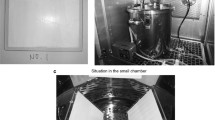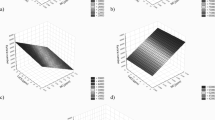Abstract
Volatile organic compounds emitted from their manufacturing have a high recycling value but contribute negatively to the environment. Paints as a significant source of volatile organic compounds could largely contribute to their emissions. This study employed four different locations close to a carpenter workshop where they make furniture and spray them with paint. The four locations (H1, H2, H3 and S1) are within a short distance from the workshop. Several analyses were performed including comfortable parameters (temperature, relative humidity, carbon dioxide, carbon monoxide, formaldehyde, ozone and nitrogen dioxide) from a paint packaging workshop. Besides that some selected volatile organic compounds in paint which was used for spraying the furniture were measured. Total volatile organic compounds for both indoor and outdoor were determined. The particulate matter at indoor and outdoor was also determined for the whole locations. Gas chromatography mass spectrometry and portable devices were used for our study. Both total volatile organic compounds and particulate matter gave very high results above the allowable concentrations. Some comfortable parameters also detected with unacceptable concentrations.









Similar content being viewed by others
Abbreviations
- VOCs:
-
Volatile organic compounds
- TVOCs:
-
Total volatile organic compounds
- CO2 :
-
Carbon dioxide
- CO:
-
Carbon monoxide
- NO2 :
-
Nitrogen dioxide
- RH:
-
Relative humidity
- HCHO:
-
Formaldehyde
- O3:
-
Ozone
- PM2.5 :
-
Particulate matter
References
ASHRAE (2013) Standard 62, 1, 2016 for the ventilation for acceptable indoor air quality
Alleson I, Levin J, Brenner S, Al Hmaidi M (2013) Peace and pollution: an examination of Palestinian-Israeli trans-boundary hazardous waste management 20 years after the Oslo peace accors. J Peacebuild Dev. https://doi.org/10.1080/15423166.2013.785651
Bekhta P, Krystofiak T, Proszyk S, Lis B (2018) Adhesion strength of thermally compressed and varnished wood (TCW) substrate. Prog Org Coat 125:331–338
Branco P, Alvim-Ferraz M, Martins F, Sousa S (2015) Children's exposure to indoor air in urban nurseries-part I: CO2 and comfort assessment. Environ Res 140:1–9
Bruno P, Caputi M, Caselli M, De Gennaro G, De Rienzo M (2005) Reliability of a BTEX radial diffusive sampler for thermal desorption: field measurements. Atmos Environ 39(7):1347–1355
Butte W, Heinzow B (2002) Pollutants in house dust as indicators of indoor contamination. Rev Environ Contam Toxicol 175:1–46
Castaño BP, Ramírez V, Cancelado JA (2019) Controlling painters’ exposure to volatile organic solvents in the automotive sector of southern Colombia. Safety and Health at Work
Chung C-W, Morandi MT, Stock TH, Afshar M (1999) Evaluation of a passive sampler for volatile organic compounds at ppb concentrations, varying temperatures, and humidities with 24-h exposures. 2. Sampler performance. Environ Sci Technol 33(20):3666–3671
Consortium HOAR (2002) Health implications of animal hoarding. Health Soc Work 27(2):125–136
de Gennaro G, Farella G, Marzocca A, Mazzone A, Tutino M (2013) Indoor and outdoor monitoring of volatile organic compounds in school buildings: Indicators based on health risk assessment to single out critical issues. Int J Environ Res Public Health 10(12):6273–6291
Ebisu K, Malig B, Hasheminassab S, Sioutas C, Basu R (2018) Cause-specific stillbirth and exposure to chemical constituents and sources of fine particulate matter Cause-specific stillbirth and exposure to chemical constituents and sources of fine particulate matter. Environ Res 160:358–364
Habil M, Massey DD, Taneja A (2013) Exposure of children studying in schools of India to PM levels and metal contamination: sources and their identification. Air Qual Atmos Health 6(3):575–587
Harb P, Locoge N, Thevenet F (2018) Emissions and treatment of VOCs emitted from wood-based construction materials: Impact on indoor air quality. Chem Eng J 354:641–652
Heseltine E, Rosen J (2009). WHO guidelines for indoor air quality: dampness and mould. WHO Regional Office Europe
Hu R, Liu G, Zhang H, Xue H, Wang X (2018) Levels, characteristics and health risk assessment of VOCs in different functional zones of Hefei. Ecotoxicol Environ Saf 160:301–307
Jodeh S, Hasan AR, Amarah J, Judeh F, Salghi R, Lgaz H, Jodeh W (2018) Indoor and outdoor air quality analysis for the city of Nablus in Palestine: seasonal trends of PM10, PM5.0, PM2.5, and PM1.0 of residential homes. Air Qual Atmos Health 11(2):229–237
Lei Z, Liu C, Wang L, Li N (2017) Effect of natural ventilation on indoor air quality and thermal comfort in dormitory during winter. Build Environ 125:240–247
Li C, Fu J, Sheng G, Bi X, Hao Y, Wang X, Mai B (2005) Vertical distribution of PAHs in the indoor and outdoor PM2. 5 in Guangzhou, China. Build Environ 40(3):329–341
Maertens RM, Bailey J, White PA (2004) The mutagenic hazards of settled house dust: a review. Mutat Res Rev Mutat Res 567(2–3):401–425
Missia DA, Demetriou E, Michael N, Tolis E, Bartzis JG (2010) Indoor exposure from building materials: a field study. Atmos Environ 44(35):4388–4395
Mølhave L, Clausen G, Berglund B, De Ceaurriz J, Kettrup A, Lindvall T, Maroni M, Pickering A, Risse U, Rothweiler H (1997) Total volatile organic compounds (TVOC) in indoor air quality investigations. Indoor Air 7(4):225–240
Ruan T, Rim D (2019) Indoor air pollution in office buildings in mega-cities: effects of filtration efficiency and outdoor air ventilation rates. Sustain Cities Soc 49:101609
Ruiz-Jimenez J, Zanca N, Lan H, Jussila M, Hartonen K, Riekkola M-L (2019) Aerial drone as a carrier for miniaturized air sampling systems. J Chromatogr A 1597:202–208
Saingam P, Baig Z, Xu Y, Xi J (2018) Effect of ozone injection on the long-term performance and microbial community structure of a VOCs biofilter. J Environ Sci 69:133–140
Tunga Salthammer T, Sibel Mentese S, Rainer Marutzky R (2010) Formaldehyde in the indoor environment. Chem Rev 110(4):2536–2572
Sergi CM (2019) Dichloromethane—a paint stripper and plastic welding adhesive. In: Nriagu J (ed) Encyclopedia of environmental health, 2nd edn. Elsevier, Oxford, pp 87–90
Sun Y, Hou J, Cheng R, Sheng Y, Zhang X, Sundell J (2019) Indoor air quality, ventilation and their associations with sick building syndrome in Chinese homes. Energy Build 197:112–119
Wei W, Mandin C, Ramalho O (2018) Influence of indoor environmental factors on mass transfer parameters and concentrations of semi-volatile organic compounds. Chemosphere 195:223–235
Weschler CJ (2006) Ozone’s impact on public health: contributions from indoor exposures to ozone and products of ozone-initiated chemistry. Environ Health Perspect 114(10):1489–1496
World Health Organization (2006) WHO Air quality guidelines for particulate matter, ozone, nitrogen dioxide and sulfur dioxide: global update 2005: summary of risk assessment. World Health Organization, Geneva
Wolkoff P (2018) Indoor air humidity, air quality, and health: an overview. Int J Hyg Environ Health 221(3):376–390
Wu T, Zhao H, Tesson S, Firoozabadi A (2019) Absolute adsorption of light hydrocarbons and carbon dioxide in shale rock and isolated kerogen. Fuel 235:855–867
Yoon C, Lee K, Park D (2011) Indoor air quality differences between urban and rural preschools in Korea. Environ Sci Pollut Res 18(3):333–345
Acknowledgements
This project was financially supported by Al Maqdesi CAMPUS FRANCE 2018–2020 and the Palestine Ministry of High Education. The authors would like to thank both the department of chemistry at An-Najah National University and University of Reims in France.
Author information
Authors and Affiliations
Corresponding author
Additional information
Editorial responsibility: M. Abbaspour.
Electronic supplementary material
Below is the link to the electronic supplementary material.
Rights and permissions
About this article
Cite this article
Jodeh, S., Chakir, A., Massad, Y. et al. Assessment of PM2.5, TVOCs, comfort parameters, and volatile organic solvents of paint at carpenter workshop and exposure to residential houses in Deir Ballout in Palestine. Int. J. Environ. Sci. Technol. 19, 775–784 (2022). https://doi.org/10.1007/s13762-020-02877-9
Received:
Revised:
Accepted:
Published:
Issue Date:
DOI: https://doi.org/10.1007/s13762-020-02877-9




